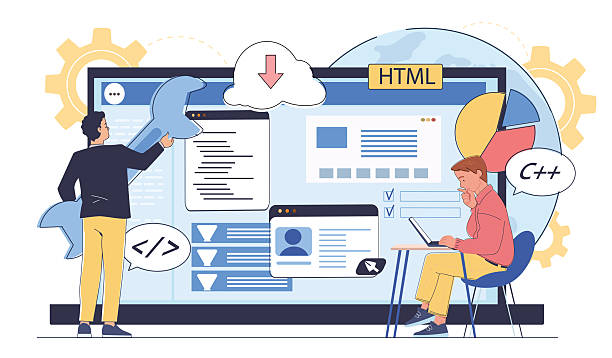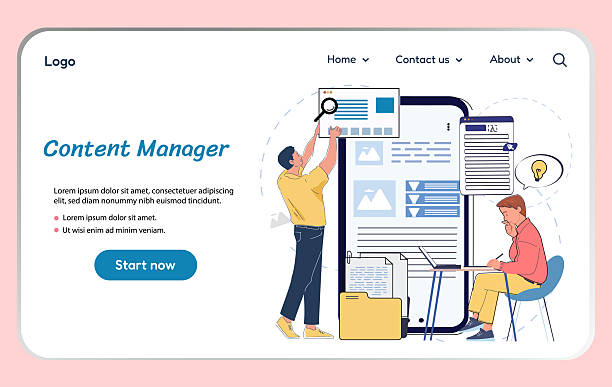Introduction to Fast Website Design and its Necessity
In today’s digital world where speed is paramount, #Fast_Website_Design is no longer a luxury but a vital necessity for every business.
Internet users have high expectations; they want web pages to load in less than a few seconds.
Any delay in website loading can mean losing potential customers, reducing conversion rates, and severely damaging your brand’s credibility.
Website loading speed not only directly impacts user experience (UX) but is also a crucial factor in site ranking on search engines like Google.
Google’s algorithms have clearly stated that website speed is one of the key ranking factors, and slower sites appear lower in search results.
This issue has become even more important with the introduction of Core Web Vitals by Google.
Fast website design means optimizing all technical and content aspects of a website so that users can access the information they need in the shortest possible time.
This process includes optimizing code, images, servers, and many other factors, which we will discuss in detail.
The importance of this topic is such that even a fraction of a second’s delay can make a significant difference in your online profitability and success.
This article will help you become familiar with the principles and techniques in this field and achieve a high-speed website with excellent performance.
Is your current e-commerce website design causing you to lose customers and sales?
Rasaweb is your solution with modern and user-friendly e-commerce website designs!
✅ Significantly increase conversion rates and sales
✅ Build strong branding and gain customer trust
⚡ Get a free e-commerce website design consultation from Rasaweb!
Key Factors Affecting Website Speed
Achieving fast website design requires a deep understanding of the multiple factors that affect website loading speed.
One of the most important factors is hosting.
Choosing a powerful and suitable host with sufficient resources, high bandwidth, and optimized servers forms the foundation of a site’s speed.
Inexpensive and shared hosts often have limited resources, which can lead to reduced site speed, especially during peak traffic.
Another factor is the optimization of images and multimedia files.
High-volume, uncompressed images can place a heavy load on the server and user’s bandwidth, significantly reducing loading speed.
Using appropriate formats (like WebP), smart compression, and Lazy Loading for images are effective solutions in this area.
Additionally, the volume and quality of website coding play a vital role.
Redundant code, render-blocking JavaScripts, and uncompressed CSS and JS files can severely slow down a website.
Code optimization, removing extra code (minification), combining files (concatenation), and using Content Delivery Networks (CDNs) for faster content delivery to global users are other important strategies for improving website speed.
Caching is also crucial; by temporarily storing data in the user’s browser or on the server, pages load significantly faster on subsequent visits.
By reviewing and optimizing these factors, faster loading and a better user experience can be achieved, resulting in increased visitor satisfaction and improved site ranking in search engines.
Choosing the Right Platform for Fast Website Design
Choosing the right platform is one of the key decisions on the path to fast website design.
Each platform has its own advantages and disadvantages that can affect the final speed of the website.
Content Management Systems (CMS) like WordPress, Joomla, and Drupal are popular solutions that offer many features due to their flexibility and numerous plugins.
WordPress, as the most widely used CMS in the world, with abundant speed optimization plugins (such as WP Rocket, LiteSpeed Cache), can be very suitable for creating a fast website, but improper use of heavy themes and plugins can reduce its speed.
In contrast, custom code website design allows for completely optimized and lightweight code, but requires high technical knowledge and more time.
Website builder platforms like Wix or Squarespace are also suitable for users without technical knowledge, but may have limitations in terms of speed optimization and offer less control over technical aspects.
Platform selection should be based on specific project needs, budget, and the team’s technical capabilities.
For example, if you need high speed and full control, custom coding or a CMS with precise optimization might be the best option.
Below, a table comparing some of these platforms from a speed perspective is provided:
| Platform | Speed Potential | Optimization Complexity | Suitable For |
|---|---|---|---|
| Custom Coding | Very High | High (Requires Developer) | Complex Projects, Maximum Performance |
| WordPress (with Optimized Plugins) | High | Medium (Requires Plugin Knowledge) | Blog, Corporate Website, Online Store |
| Joomla/Drupal | Medium to High | Medium to High | Large Portals, Government Websites |
| Wix/Squarespace | Medium | Low (Limited Control) | Small Businesses, Portfolios |
Image and Multimedia Optimization Techniques
Images and multimedia files are often the biggest contributors to website slowness.
Optimizing these elements is a critical step in fast website design.
The first step is choosing the right image format.
Newer formats like WebP can significantly reduce file size while maintaining visual quality.
WebP averages 25-35% smaller file sizes than JPEG and PNG.
Using image compression tools like TinyPNG or Compressor.io can also help reduce size without noticeable quality loss.
The next step is setting the correct image dimensions.
Loading an image with dimensions much larger than its display space on the page imposes unnecessary and excessive load on the server and the user’s browser.
Images should be loaded in sizes appropriate to their actual dimensions on the website, and the Responsive Images feature in HTML (using srcset and sizes) should be used so that the browser can select the image with the appropriate dimensions based on the user’s screen size.
The Lazy Loading technique is also one of the most effective methods for improving initial page load speed.
With this method, images and videos are only loaded when the user scrolls to the relevant section of the page.
This ensures that the browser only loads essential resources initially, reducing the initial page loading time.
For videos, hosting them on platforms like YouTube or Vimeo and embedding them on your site (rather than directly uploading video files to your server) can help improve performance and fast page loading experience.
By applying these techniques, website loading speed can be significantly improved, providing a smoother experience for users.
Do you dream of a thriving online store but don’t know where to start?
Rasaweb is your comprehensive e-commerce website design solution.
✅ Attractive and user-friendly design
✅ Increased sales and revenue⚡ Get a free consultation
The Role of Hosting and CDN in Website Loading Speed
Web hosting infrastructure and Content Delivery Networks (CDNs) are key pillars in achieving fast website design.
The choice of hosting type directly impacts your website’s speed, security, and stability.
Shared Hosting is the cheapest option, but server resources are shared among multiple websites, which can lead to reduced speed during peak traffic or high activity from other sites.
For websites with medium to high traffic, Virtual Private Server (VPS) hosting or Dedicated Servers are better options that provide dedicated resources and more control, ensuring higher speeds.
Another important factor in hosting is the server geographical location; the closer the server is to your target audience, the lower the latency and the faster the loading speed.
Alongside hosting, using a CDN (Content Delivery Network) is crucial for improving high website speed.
A CDN is a network of servers located in different parts of the world that store a copy of your website’s static content (such as images, CSS, JavaScript).
When a user visits your site, the CDN delivers the content from the server closest to them.
This reduces the physical distance and, consequently, the loading time.
CDNs are particularly effective for websites with global audiences or high traffic and can offload pressure from your main server.
Proper CDN implementation, along with choosing a strong hosting service tailored to your needs, can significantly contribute to your website’s speed and stability, providing a better user experience.
Click here to preview your posts with PRO themes ››
The Importance of Clean and Optimized Coding in Fast Website Design
Coding is the backbone of any website, and its quality directly impacts fast website design.
Messy, redundant, and unoptimized code can severely reduce page loading speed.
One of the fundamental principles in this area is code minification and compression.
This process involves removing extra characters such as white spaces, new lines, comments, and long variable names from HTML, CSS, and JavaScript files.
Although these changes may seem minor, in large volumes, they significantly reduce the overall file size and shorten their transfer time.
Also, file concatenation means merging several small CSS or JavaScript files into one larger file to reduce the number of HTTP requests to the server.
Each HTTP request requires time for round-trip to the server, and reducing their number directly affects loading speed.
Another point is asynchronous loading or deferred loading for JavaScript files.
By default, browsers wait for all HTML content to load before processing JavaScript files, which can cause “render-blocking” and delay in page display.
By using the async or defer attributes, the browser can be forced to load JavaScript files in the background without interrupting the loading of other page elements.
This means web speed optimization and a significant improvement in the initial perceptible loading time (First Contentful Paint).
Developers should continuously review and optimize their code to use minimum resources for maximum efficiency and ensure a smooth user experience.
Website Speed Measurement and Analysis Tools
To ensure your efforts in fast website design have been fruitful, regular website speed measurement and analysis are highly important.
Several tools are available for this purpose, each providing valuable information about your site’s performance and identifying strengths and weaknesses.
Google PageSpeed Insights is one of the most widely used tools, offering both laboratory data (Lab Data) and field data (Field Data).
This tool provides scores for site performance on mobile and desktop devices and offers suggestions for improvement, especially regarding Core Web Vitals.
GTmetrix is another powerful tool that provides more details on loading time, number of requests, and page size.
This tool also supports Core Web Vitals and provides accurate Waterfall Charts that show you how much time each part of the website needs to load.
Pingdom Tools, similar to GTmetrix, provides comprehensive information about site performance, including loading time, page size, number of requests, and server response time.
For website speed optimization, a single test is not enough; you should regularly monitor your site and measure the changes made.
These tools help you identify speed bottlenecks and make informed decisions based on accurate data to improve your fast website design.
Below, a table of these tools and their key features is provided:
Click here to preview your posts with PRO themes ››
| Tool Name | Key Features | Main Advantage |
|---|---|---|
| Google PageSpeed Insights | Mobile and Desktop Score, Core Web Vitals, Optimization Suggestions | Based on Google data and real user experience |
| GTmetrix | Waterfall Chart, Performance Summary, PageSpeed and YSlow Scores | Deep and visual analysis for problem identification |
| Pingdom Tools | Total Loading Time, Page Size, Number of Requests, Waterfall Chart | Simple user interface, testing from different locations worldwide |
| WebPageTest | Advanced Testing, Browser Selection, Connection Simulation, Load Video Recording | High customization capabilities for deeper analysis |
User Experience and its Impact on Website Speed
Website speed is not just a technical factor but a very important element in shaping user experience (UX).
In fact, a fast website design directly leads to a positive user experience, and slow sites can easily drive users away.
Research has shown that even a few hundred milliseconds delay in page loading can significantly increase the bounce rate and decrease the conversion rate.
Today’s users are impatient; they expect information to be readily available.
When a site loads slowly, users feel dissatisfied, become frustrated with interacting with content, and are likely to leave the page and go to a competitor’s website.
This not only damages brand credibility but also directly impacts business revenue and goals.
For this reason, web speed optimization should be at the core of the UX strategy.
When a site is fast, users can easily navigate it, quickly view content, and promptly achieve their goals.
This leads to increased time spent on the site, more page views, and ultimately, a higher likelihood of desired actions such as purchasing, signing up, or contacting.
Furthermore, high site speed means reduced need for server resources and, consequently, lower operating costs.
Therefore, investing in fast website design is an investment in customer satisfaction and long-term business success.
Did you know a weak corporate website loses you many opportunities daily? Solve this problem forever with professional corporate website design by Rasaweb!
✅ Create a powerful and trustworthy image for your brand
✅ Attract new target customers and increase sales
⚡ [Get a free website design consultation]
Future Trends and Challenges in Fast Website Design
The web world is rapidly changing, and new trends constantly impact the field of fast website design.
One of the most important trends is the advancement of communication protocols.
HTTP/3, the latest version of the HTTP protocol, using the QUIC protocol, promises to significantly improve the speed and security of data exchange.
This protocol performs better, especially in unstable and mobile networks, helping to reduce latency.
Widespread use of Brotli compression, which is more efficient than Gzip, also helps reduce the size of text files (HTML, CSS, JS) and consequently increases loading speed.
The main challenge in this area is browser and server support for these new technologies, which requires continuous updating of infrastructures and software.
Another trend is the continued move towards Mobile-First Indexing by Google, which means prioritizing the mobile version of the site for indexing and ranking.
This requires web designers to first consider optimizing speed and user experience on mobile devices.
Core Web Vitals, as Google’s main metrics for measuring user experience, are also continually evolving, and designers must constantly optimize their websites based on these metrics.
Future challenges include the increasing complexity of websites using heavy JavaScript frameworks, as well as users’ growing expectations for speed and interactivity.
To stay competitive, fast website design professionals must continuously update their knowledge and utilize the latest technologies and best practices to deliver high-performance websites.
Click here to preview your posts with PRO themes ››
The Importance of Responsiveness and Speed on Mobile Devices
With the increasing use of smartphones to access the internet, the importance of Responsiveness (Responsive Design) and speed on mobile devices for fast website design has become a priority.
Currently, more than half of web traffic comes from mobile devices, and this trend continues to grow.
If your website is slow and unusable on mobile, you will effectively lose half of your audience.
Responsive design means that your website can automatically adjust to the screen size of the user’s device and provide the best visual experience.
But responsiveness is not just about appearance; loading speed on mobile is also critical.
Mobile users often use slower or less stable internet connections, and their device battery is also limited.
Therefore, every extra megabyte or every second of delay can severely disrupt their experience.
Google, with the introduction of Mobile-First Indexing, has clearly shown that the mobile version of a site is the basis for ranking in search results.
This means that if your site’s mobile version is slow, regardless of how fast the desktop version is, you will likely not rank well in search results.
Therefore, focusing on mobile image optimization, code compression, using AMP (Accelerated Mobile Pages) if necessary, and ensuring that your hosting meets the needs of mobile traffic are prerequisites for fast website design in the current era.
A website that works quickly and smoothly on mobile not only achieves a better ranking on Google but also significantly increases user satisfaction and ultimately greatly contributes to the growth of your business.
Frequently Asked Questions
| No. | Question | Answer |
|---|---|---|
| 1 | What is the concept of “Fast Website Design”? | Designing a website that loads in the shortest possible time and provides a smooth user experience, with an emphasis on performance optimization. |
| 2 | Why is website loading speed important for users? | Today’s users have little patience; slow websites lead to premature page abandonment, poor user experience, and loss of visitors. |
| 3 | What impact does fast website design have on SEO? | Search engines like Google consider site speed as one of the ranking factors. Faster websites achieve better rankings in search results. |
| 4 | What are the main factors affecting website speed? | Image optimization, caching, CSS and JS file compression, using strong hosting, reducing HTTP requests, and optimized coding. |
| 5 | How can website loading speed be measured? | By using tools like Google PageSpeed Insights, GTmetrix, Lighthouse, and Pingdom Tools, which provide detailed performance reports. |
| 6 | What is the role of images in website speed and how should they be optimized? | High-volume images can severely reduce site speed. They should be compressed, modern formats (like WebP) should be used, and the Lazy Load technique should be utilized. |
| 7 | What is the importance of choosing appropriate hosting in fast website design? | A powerful and high-speed hosting (preferably SSD) with optimized servers close to target users is the foundation of a website’s speed. |
| 8 | How does Caching help increase website speed? | Caching allows the user’s browser to store copies of website files, so on subsequent visits, there’s no need to reload all content, and the site is displayed faster. |
| 9 | Is using a CDN (Content Delivery Network) recommended in fast website design? | Yes, CDN significantly increases loading speed by storing copies of website content on various geographical servers and delivering it from the closest server to the user. |
| 10 | What are the key tips for developers to design a high-speed website? | Writing clean and optimized code, minimal use of plugins, optimizing database queries, using lightweight frameworks, and implementing Lazy Load for content. |
And other advertising services of Rasa Web Advertising Agency
Smart Advertising Campaign: A fast and efficient solution for attracting customers, focusing on Google Ads management.
Smart Custom Software: Designed for businesses seeking to analyze customer behavior through key page optimization.
Smart SEO: Transform sales by leveraging real data.
Smart Direct Marketing: An effective tool for campaign management with the help of attractive UI design.
Smart Sales Automation: A combination of creativity and technology to improve SEO ranking through SEO-driven content strategy.
And hundreds of other services in internet advertising, advertising consultation, and organizational solutions
Internet Advertising | Advertising Strategy | Sponsored Content
Resources
Comprehensive Guide to Website Speed Optimization Iran Host
Increase WordPress Speed – HamyarWP
Web Ramz Fast Website Design Tips
Mihan Blog Post: Web Speed Optimization
? For your business to shine in the digital world, from personal website design to comprehensive marketing campaigns, RasaWeb Digital Marketing Agency offers creative and results-driven solutions.
📍 Tehran, Mirdamad Street, next to the Central Bank, South Kazeroon Alley, Ramin Alley, No. 6














